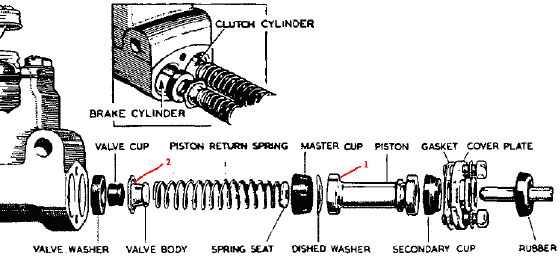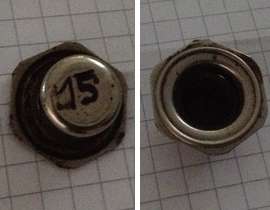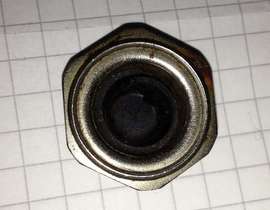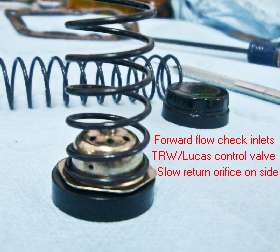The MGA With An Attitude
Dragging Brakes, MASTER CYLINDER FAULT #1 - BT-101A
There has been a recent run of a particular fault in a new replacement part master cylinder. The problem is that the brake hydraulic system will release most of the residual pressure so you can drive the car, but it retains a little residual pressure, just enough to make the brakes drag a bit and get hot while driving. The heat is bad for cooked grease in wheel bearings, worn brake linings, warped drums or rotors, and poor fuel mileage. Symptoms are that the brakes seem to operate normally, except that one or more wheels will be hot after driving, and there will be significant resistance to turning the wheel by hand. When you open the bleed nipple to relieve hydraulic pressure, the wheel may turn freely. If you simply let it rest for 10 minutes after driving, when it cools down the brakes may not drag. This fault may be related to a single production run of the master cylinders, not necessarily affecting all parts from the same manufacturer, and the issue might be resolved with later production. Meanwhile there is a way to fix it, so you don't have to buy another new master cylinder.
Before you start tinkering with the master cylinder, consider the more common problem. If the dragging brake issue affects only one front wheel, or only two rear wheels, then check first for condition of the hydraulic hose. An old hose may decompose, swelling inside to constrict and inhibit return flow of fluid. If the hoses are more then 10 years old (20 for sure) or of unknown age, it is a good idea to replace the hoses regardless (and ditto for a clutch hose).
If you determine that your master cylinder has this problem, you should notify the vendor selling these parts. Whether you return the part or not, the vendor needs to know about the problem before anything can be done about it on the supply end.

Refer to the diagram above (click for larger image). The brake side of the master cylinder has a few parts not used in the clutch side, namely valve washer, valve cup, and valve body.
Read the Workshop Manual page M.6 for a description of these parts and how they work. The book calls these parts the "inlet and outlet check valve". It is sometimes referred to as the "non-return valve", which is a bit of a misnomer. I prefer to call it "slow return valve". The purpose of these parts is to restrict or slow down the return of fluid to the master cylinder, allowing time to enable the driver to "pump up" the brakes in case of a low pedal condition. The valve body has holes in the sides. The small rubber cup inside of the valve body has a flexible skirt. This serves as a check valve to allow free forward flow of fluid but no return flow. That is the non-return or check valve function.


Unfortunately the book stops a bit short of finishing a full description of function of this valve. The book says it retains about 8 psi residual pressure in the system. This is a function of the diameter of the "valve body" and strength of the compression spring, serving as a pressure relief valve. When you push the pedal full stroke you get high pressure to operate the brakes. When you release the pedal you want the brakes to release immediately, or at lease drop the pressure enough to reduce braking friction to a minimum (nearly nil). When releasing the pedal, high pressure in the system will upset the valve body from the rubber valve washer allowing immediate return of some fluid flowing back between the rubber washer and the valve body. The residual pressure (due to the spring force) will be around 8 psi while the fluid is flowing back past the valve washer. When a small amount of fluid has returned, the brake shoes and pads will have very much reduced force, barely touching the drums or rotors, so the wheels will turn (with only a small amount of drag on the brake linings). A second or so later the brake shoes will have returned completely to their rest stops, because the shoes have strong return springs, so drum brakes will not drag.
Now to take up where the book left off. Long term retention of the residual pressure is NOT normal. If the system would always hold the fluid in this condition, the pads and shoes would never withdraw from the rotors and drums. It would then not be necessary to ever adjust the shoes in drum brakes, because they would be self compensating for wear, similar to the clutch slave cylinder, always keeping the shoes in contact with the drum. When pads or shoes are always touching the rotor or drum the resulting friction will make heat, and brake fluid will stay warm or get hotter. Heating brake fluid will expand, which would in turn cause a bit more fluid to return past the valve washer, maintaining 8 psi residual pressure in the system and continuing friction heating of the brake parts. When the vehicle stops and remains still for a while the brake parts and fluid can cool down, the fluid will contract, and any residual pressure in the system will vanish. This is why if you let it set for half an hour the wheel will turn freely.
As said, long term retention of residual pressure is NOT normal. In fact the residual pressure should vanish within a few seconds of brake release. If it doesn't, there is something wrong with the inlet and outlet control valve. This is the last bit the book doesn't mention. Think of this as a very small amount of leakage back past the Valve Body, specifically so that it will NOT hold the residual pressure indefinitely. What is needed here is a small orifice that will allow fluid to flow freely but very slowly through the valve body.
Look at the image showing internal parts of the master cylinder, and notice numbers and pointers in red. #1 is location of some small holes in the piston that allow forward flow of fluid during the return stroke. This is where fluid enters the pressure chamber to "pump up" the brakes during multiple stroke operation. #2 is pointing at a spot at the inside corner of the Valve Body flange. You can drill a small hole here (maybe 1/32 inch diameter) to serve as the restricting return orifice. The hole needs to be located within the ID of the Valve Washer, and downstream from the edge of the Valve Cup. This hole can be quite small so it does not defeat the pump up function. What it will do is to allow bleed off of any residual pressure within a few seconds of final pedal release (similar to you opening a bleed nipple at the wheel). This will then assure that the 8 psi residual pressure does not persist for long after final release of the brakes.
This problem is fairly rare. It is related to a particular manufacturer who uses piston return springs that are too stiff, causing residual pressure of 12-psi rather than the original intended 8-psi. The small drilled hole will solve the problem.
Addendum August 6, 2011:
Thanks to some feedback from Ron (emgeeaa) in British Columbia, Canada, this problem is known to exist in a current batch of TRW/Lucas master cylinders. Ron has two of them in his possession with the same problem. Other people have been reporting this problem for a couple of years (I just didn't know the manufacturer before).
Ron did some pressure measurements and determined that this master cylinder holds 12-psi residual pressure indefinitely, which is why the brakes drag and get so hot. Apparently the spring that returns the master cylinder piston has too high force for this application, and there is no provision to bleed off the excess residual pressure. Now that the source of the problem has been identified, perhaps we can get TRW/Lucas to fix it. No telling what may happen to hundreds or perhaps thousands of units already in the field or in the distribution system.
Addendum May 27, 2012:
This is a picture of the (non-original) non-return valve in the TRW/Lucas master cylinder. Notice the small hole drilled in the side of the steel valve body to serve as the slow-return pressure relief. The high residual pressure problem is apparently caused by the piston return spring being too strong. See more on the next page about the TRW/Lucas master cylinder.
|

|
Addendum December, 2012:
This has been around for at least a few years now and doesn't seem to be going away.
On 12/15/2012, CHARLES GOLD wrote:
"I had my brake system completely sorted on my 1960 MGA roadster, using new NOS drums, new shoes, discs/pads already OK, all new brake hoses, and a new TRW master cylinder about two weeks ago. The job itself was done very nicely. It appears that the problem is not necessarily fixed. I have a noticeable dragging, which holds me on a slight hill, and I can feel when I roll to a stop that the brakes are lightly applied. Also, it seems the gas mileage is pretty low. -- Chuck Gold
|